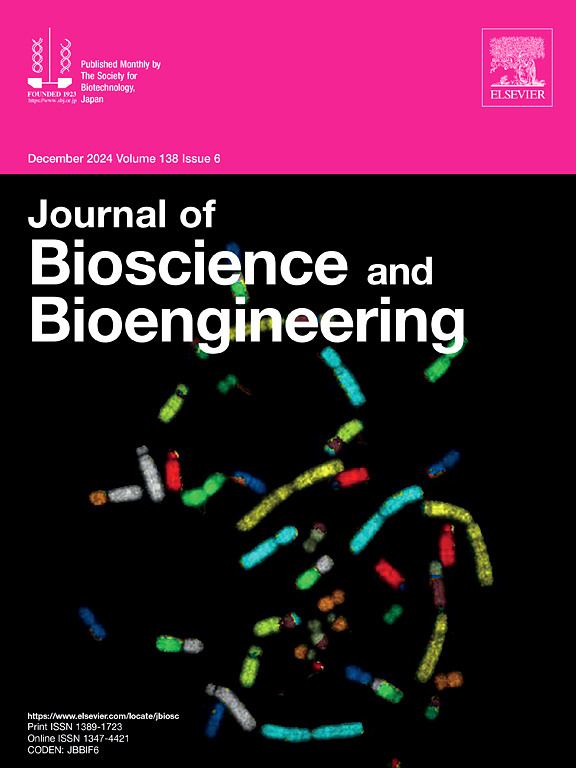Screening of Leuconostoc mesenteroides strains suitable for kimoto-style brewing of sake with high antioxidant capacity
IF 2.3
4区 生物学
Q3 BIOTECHNOLOGY & APPLIED MICROBIOLOGY
引用次数: 0
Abstract
Sake brewed using the kimoto-style exhibits high antioxidant capacity and is expected to inhibit the deterioration of sake quality due to oxidation. However, the antioxidant capacity of the added lactic acid bacteria has not been explored. We aimed to screen the lactic acid bacterium, Leuconostoc mesenteroides, with excellent brewing and antioxidant capacity, to develop sake with high antioxidant capacity. Three Le. mesenteroides strains (19-2, 19-5, and 19-23) were selected from eight screened strains based on their alcohol intolerance, growth performance in koji extract, aroma compound, and low biogenic amine production. Among these, Le. mesenteroides 19-23 exhibited a significantly higher hydrophilic-oxygen radical absorbance capacity (H-ORAC) in the culture medium than the control strain, Le. mesenteroides NBRC102481. In a medium-scale sake brewing test, sake prepared with Le. mesenteroides 19-23 had a significantly higher H-ORAC value than that prepared using the sokujo-style (without Le. mesenteroides). Additionally, metabolome analysis using capillary electrophoresis time-of-flight mass spectrometry identified ferulic acid, p-coumaric acid, 3-hydroxyanthranilic acid (3-HAA), and 6,8-thioctic acid in the main mash. High-performance liquid chromatography-based quantification revealed that antioxidants in the unrefined filtrates of the main mash prepared using the kimoto-style tended to be more abundant than in those prepared using the sokujo-style. Specifically, 3-HAA and ferulic acid were more concentrated in some unrefined filtrates of the kimoto-style than sokujo-style. In conclusion, the screened Le. mesenteroides strain demonstrated potential for brewing sake with high antioxidant capacity using the kimoto-style, offering a promising method for antioxidant-rich sake production.
筛选适合生酛式清酒酿造、抗氧化能力强的中生白僵菌菌株。
使用和式酿造的清酒具有很高的抗氧化能力,有望抑制因氧化而导致的清酒质量恶化。然而,添加的乳酸菌的抗氧化能力尚未得到探索。目的筛选具有优良酿造和抗氧化能力的乳酸菌——肠系膜Leuconostoc mesenteroides,开发具有高抗氧化能力的清酒。三个勒。根据筛选菌株19-2、19-5和19-23的酒精耐受性、在曲提取物、香气化合物中的生长性能和低生物胺产量,从8个筛选菌株中筛选出肠系膜菌(19-2、19-5和19-23)。其中,乐。肠系膜菌19-23在培养基中的亲水性氧自由基吸收能力(H-ORAC)显著高于对照菌株Le。mesenteroides NBRC102481。在一次中等规模的清酒酿造试验中,清酒用乐配制。肠系膜19-23的H-ORAC值显著高于未加Le的sokujo型。mesenteroides)。此外,利用毛细管电泳飞行时间质谱法进行代谢组学分析,鉴定出主醪中的阿魏酸、对香豆酸、3-羟基苯甲酸(3-HAA)和6,8-硫辛酸。基于高效液相色谱的定量分析表明,和服制的主醪未精制滤液中的抗氧化剂含量往往高于烧酒制的主醪。具体来说,和服风格的一些未精制滤液中3-HAA和阿魏酸的浓度高于烧服风格。综上所述,筛选乐。肠系膜菌显示出利用和式酿造高抗氧化能力清酒的潜力,为生产富含抗氧化剂的清酒提供了一种有前景的方法。
本文章由计算机程序翻译,如有差异,请以英文原文为准。
求助全文
约1分钟内获得全文
求助全文
来源期刊

Journal of bioscience and bioengineering
生物-生物工程与应用微生物
CiteScore
5.90
自引率
3.60%
发文量
144
审稿时长
51 days
期刊介绍:
The Journal of Bioscience and Bioengineering is a research journal publishing original full-length research papers, reviews, and Letters to the Editor. The Journal is devoted to the advancement and dissemination of knowledge concerning fermentation technology, biochemical engineering, food technology and microbiology.
 求助内容:
求助内容: 应助结果提醒方式:
应助结果提醒方式:


